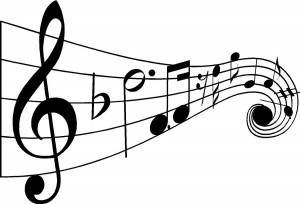By Dave Austin the “Music Professor”
As DJs, we know and play a lot of music, but how much do we really know about the songs we work with? I’m fortunate to have studied and played music and have a basic understanding of musical structure. However, not everyone had such an opportunity, so let me offer some key elements which may help to better understand the structure of the music we’re playing, and hopefully, improve our performances.
First, most songs in popular music are sectional, repeating forms. The most common form is the 32-bar form (ONE, 2, 3, 4 – TWO, 2,3,4 – THREE, 2,3,4 – FOUR, 2,3,4, etc. to a complete 32-bar section). The 32-bar form uses four sections, usually eight bars long (4 x 8 = 32), two verses and a bridge or middle 8, then a repeat of verse one in the last section. Some examples are: Rihanna- “Umbrella,” “Stronger” by Kelly Clarkson, Justin Bieber’s “Boyfriend,” Taylor Swift’s “We Are Never Ever Getting Back Together” and Adele’s “Someone Like You.” Much of today’s pop music uses the 32-bar form and rarely uses different music for each stanza, or line of the lyrics.
At the foundation of popular music are the verse and the chorus – both essential elements with the verse played or sung first. Each verse uses the same music (possibly with some slight variations), and only the lyrics change from verse to verse. A notable exception to this “rule” is the Beatles’ “She Loves You.”
After the verses comes the chorus or “refrain,” most often a melody and lyrical phrase which is repeated and often contains the song’s title. Some pop songs have an introduction and a coda (the Italian word for “tail”, a concluding musical section that’s different from the main structure and used as a “closing statement”). Verses and choruses are often connected by a bridge – a segment which links the verse and the chorus at one or more points during the song. Throughout the song, the verse and the chorus are repeated until it reaches the bridge. The bridge (along with the intro and coda, also called an “outro”) are usually are only used once.
There can be a solo section in the song played by one or more instruments. This part of the song can be part of the melodic line used by the singer or it can be improvised following the song’s chord progression.
Now let’s look briefly at each of these sections in a bit more detail.
The introduction is a unique part of the song which comes at the beginning. Most often the intro will be just music and no words. It’s used to build suspense so that when the downbeat drops, it creates a release or surprise. In some songs (particularly dance-oriented tracks) there may be only drums or percussion during the intro, setting up the groove. However, this intro may also be sung by the lead or backup singers or played on a guitar, keyboard or other instrument.
The verse is the main part of the song, roughly corresponding with the lines of a poem. When two or more sections of the song have the same music but different lyrics, each section is considered a verse. Let’s don’t confuse a verse with a pre-verse which is a short one or two bar phrase between the intro and the first verse. If you want examples of pre-verses, check out the surf music of the 1960s.
Almost of greater emotional intensity than the verses, the chorus conveys the main message or theme – and usually contains the “hook.” In pop music, the chorus usually follows the verse, but there are notable recent exceptions: “Can’t Buy Me Love,” Beatles, “Imma Be,” Black Eyed Peas, Pink’s “Get the Party Started” and Linkin Park’s “Crawling.”
The middle 8 is that part which has a significantly different melody from the rest of the song. These sections often have new chords, but frequently just alternate between two chords. It’s called the middle 8 simply because it happens in the middle of the song and is generally 8 bars in length. Also, these middle 8s are usually quieter than the rest of the song. A middle 8 can also be used to create energy, and by hitting a powerful upbeat, musicians can add a big hook for the ending chorus or finale.
It may seem that no modern pop song would be complete without an instrumental solo. In some songs, the soloist plays the same melodies as the lead singer, often with embellishments, riffs, scale runs, etc. In some cases, the instrumentalist may improvise or ad lib the solo.
Ad lib, or Latin Ad Libitum for “at will” happens when the lead or second lead vocal departs from the established lyric or melody in order to add interest and intensity to the end of a song. Ad libs often repeat previous lines of the song while adding variations, and in some cases, even new lyrics. During this part of the song, the rhythm may become less structured or stop entirely, turning things over to the vocalist to create his or her own variations.
So, even though greatly simplified, this may a bit technical. However, on the practical side, being able to count musical bars and identify segments of a song is essential to our jobs as DJs. We don’t have to be music experts, but when we’re mixing or editing songs, we must be keenly aware of these elements – whether we know their proper names or not. A song edit with one beat missing, one beat too many or an edit in the wrong place just doesn’t sound right and can throw an entire dance floor out of rhythm.
CLICKL HERE for additional information on this topic.

